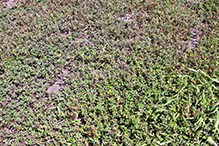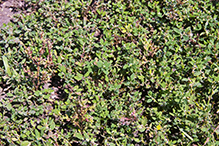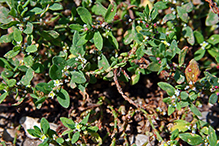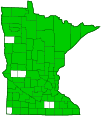prostrate knotweed
(Polygonum aviculare)
Overview • Description • Distribution • Taxonomy
Description |
||
There are six subspecies of prostrate knotweed in North America, five of which occur in Minnesota. They vary greatly in appearance. However, in areas where two subspecies occur, populations intergrade in a complex way. According to Flora of North America, this makes identification to the subspecies level impractical. The stems are flexible, semi-erect to sprawling, and 1′ to 6′ long. The nodes are translucent, becoming jagged. The sap is highly acidic but clear, not milky. The leaves are green or grayish-green and variable in shape. Leaf blades may be narrowly ellipse-shaped, egg-shaped, or spatula-shaped. Flowers appear in small clusters at the leaf axils. Flowers are produced from August to October. The flowers may be green or reddish-brown, and may have white, pink, or reddish margins. The outer 3 petal-like sepals are not longer than the petals, however this is not visible without a hand lens. |
||
Distribution |
||||
|
Sources |
|||
| 5/31/2023 | ||||
Taxonomy |
|||
| Kingdom | Plantae (green algae and land plants) | ||
| Subkingdom | Viridiplantae (green plants) | ||
| Infrakingdom | Streptophyta (land plants and green algae) | ||
| Superdivision | Embryophyta (land plants) | ||
| Division | Tracheophyta (vascular plants) | ||
| Subdivision | Spermatophytina (seed plants) | ||
| Class | Magnoliopsida (flowering plants) | ||
| Superorder | Caryophyllanae | ||
Order |
Caryophyllales (pinks, cactuses, and allies) | ||
Family |
Polygonaceae (knotweed) | ||
| Subfamily | Polygonoideae | ||
| Tribe | Polygoneae | ||
| Subtribe | Polygoninae | ||
Genus |
Polygonum (knotweed) | ||
Subordinate Taxa |
|||
box knotweed (Polygonum aviculare ssp. buxiforme) common knotweed (Polygonum aviculare ssp. aviculare) narrow-leaf knotweed (Polygonum aviculare ssp. neglectum) narrow-leaf knotweed (Polygonum aviculare ssp. rurivagum) northern knotweed (Polygonum aviculare ssp. boreale) oval-leaf knotweed (Polygonum aviculare ssp. depressum) |
|||
Synonyms |
|||
Polygonum aviculare var. vegetum Polygonum heterophyllum Polygonum monspeliense |
|||
Common Names |
|||
prostrate knotweed yard knotweed |
|||
Visitor Photos |
|||||
Share your photo of this plant. |
|||||
| This button not working for you? Simply email us at info@MinnesotaSeasons.com. Attach one or more photos and, if you like, a caption. |
|||||
|
|||||
MinnesotaSeasons.com Photos |
|||||
Colony |
|||||
 |
 |
||||
Plant |
|||||
 |
|||||

Slideshows |
||
| Polygonum aviculare Susanne Wiik |
||

|
||
About
Tungress, Knotgrass |
||
| Polygonum aviculare Matt Lavin |
||

|
||
About
Introduced annual (and perennial) with generally prostrate stems, whitish tepals tinged with rose, common in highly disturbed settings including along sides of roads, trails, sidewalks, lawns, curbs, and similar town settings. |
||
| Polygonum aviculare Cristina Corral |
||
About
Cristina Corral http://www.pfaf.org/user/Plant.aspx?LatinName=Polygonum+aviculare http://www.ars-grin.gov/cgi-bin/npgs/html/taxon.pl?29238 |
||

Visitor Videos |
|||
Share your video of this plant. |
|||
| This button not working for you? Simply email us at info@MinnesotaSeasons.com. Attach a video, a YouTube link, or a cloud storage link. |
|||
Other Videos |
|||
| Polygonum aviculare Novenyismeret |
|||
About
Uploaded on Oct 8, 2008 Polygonum aviculare |
|||
| EL CIENNUDOS: Polygonum aviculare (http://riomoros.blogspot.com.es) Published on Sep 14, 2012 |
|||
About
Published on Sep 14, 2012 El Ciennudos (Polygonum aviculare) es una planta herbácea anual de la familia Polygonaceae y origen en Europa. Su desarrollo es rastrero pudiendo llegar a 1 m de longitud. Puede tomar carácter erguido en determinadas condiciones. Los tallos parten de un punto central, donde se unen a la raíz, y se extienden radialmente ramificándose. Tiene nudos y entrenudos. De los nudos salen las hojas y flores y, de algunos, salen nuevas ramas. Son de color verde oscuro grisáceo, con líneas longitudinales. Las hojas son simples, de peciolo muy corto, de forma elíptica, con el borde liso y color verde oscuro a glauco. Las flores son pequeñas, solitarias o en grupos pequeños, apareciendo en la axila de las hojas. Tienen la corola con cinco pétalos de color blanco a rosado. El fruto es un aquenio. En la naturaleza se da en zonas ruderales y campos de cultivo y barbechos. Es una buena cobertora de suelos para evitar la erosión en las etapas iniciales de restauración. Más información sobre El Ciennudos (Polygonum aviculare) en: http://riomoros.blogspot.com/2012/10/el-ciennudos-polygonum-aviculare.html |
|||

Visitor Sightings |
|||||
Report a sighting of this plant. |
|||||
| This button not working for you? Simply email us at info@MinnesotaSeasons.com. Be sure to include a location. |
|||||
|
|||||
MinnesotaSeasons.com Sightings |
|||||

|
Created: Last Updated: © MinnesotaSeasons.com. All rights reserved. |
